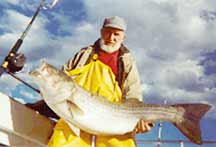 The Old: Setting the Measure for Bay Fishermen: Capt. Al Jones
The Old: Setting the Measure for Bay Fishermen: Capt. Al Jones
story & photos by Capt. Jim Brincefield
I am often asked by anglers new to fishing in Chesapeake Bay what makes a great Bay fisherman. That’s a question easy to answer by example. From around these parts come many great fishermen: Some are no longer fishing with us; others are retired; still others are active as ever.
For some reason, it seems that great Bay fishermen gain more respect from their peers after they get old, retire or eventually pass on. What was it like to fish here with such legends? What secrets and advice would they have had for me? Would they have taken me under their wing and taught me how to become a better fisherman, a better father, a better friend, a better businessman, a better man? Would they have passed on the secrets that were passed down over generations from their mentors?
Luring Capt. Al
All that and more has come to me after I convinced an extremely reluctant Capt. Al Jones, of Shady Side, to teach me his craft.
A few years back, my first mate, Lumpy, got into a bit of trouble at his high school - enough that his father came to me with the news that Lumpy would no longer be my first mate. My customers were disappointed that following year because, in addition to being a good, young first mate, Lumpy was his own floor show on the deck of the Charlotte K. Our customers loved his antics, humor and sunny disposition.
Anyway, I had been pestering Capt. Al Jones for many years to teach me his craft. Capt. Al is regarded as one of the best fishermen on Chesapeake Bay. When I asked him to step in as my first mate, I got what one usually gets from Capt. Al: a furrowed eyebrow, a hurrumph and the patented Capt. Al Jones brush off. As Jerry Seinfeld said: “not to say this is a bad thing …”
I think the more ornery a senior captain becomes over the years, the more he will fit into the mold of the salty old dogs that set the measure. If Capt. Al didn’t display these legendary traits, he would not qualify for his peers’ admiration. Nor for this story.
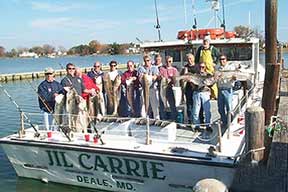 Learning from Capt. Al
Learning from Capt. Al
At last, for reasons that remain unknown, Capt. Al Jones agreed to fish with me and to teach me. I was elated. Over the next years, Capt. Al took me under his wing and taught me more than I could imagine. He even helped me build my new charter boat, the Jil Carrie. Of course, getting any tidbit of information from him is like trying to open a Chesapeake Bay oyster with a toothpick.
As I have learned time and again.
Some days you can’t get a bite no matter what you try. On these days, I pull what small amount of hair is left on my head out, rant and rave about the boat and storm and pray to the fish gods for relief from my horrible plight. Of course, this has no effect on my catch. In fact, this type of behavior usually makes things worse. This kind of day invariably occurs with new customers on board.
On one such day, when things could get no worse, I begged Capt. Al to enlighten me:
Me: “What am I doing wrong? You’re supposed to be teaching me and you’re just sitting back here with one of those smug looks.”
Capt. Al: “Capt. Croakerhead, when you figure it out, let me know.”
Me: “Kind of a lame answer from someone with so much knowledge and experience, wouldn’t you say?”
That’s what I thought at first. But over the years, Capt. Al has explained his greater message to me in many subtle ways.
The message is that no matter how good you are, no matter how good your gear, boat and fishing experience have grown to be, there is one overriding factor: Sometimes the fish just won’t bite. It’s that easy. It all comes down to one important thing: Listen. Learning to do that would bring me experience, patience, wisdom and humility.
Capt. Al still fishes with me today, bringing much skill and experience with him on each voyage - along with the furrowed eyebrow and hurrumph.
Capt. Al has taught me about fishing, about life, about being a father and about being a friend.
Capt. Jim Brincefield, of Deale Beach, writes and shoots photos by moonlight.
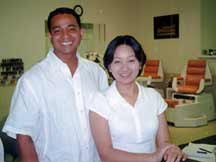 The New: Their Fingerhold on Success: Chesapeake Country’s Vietnamese Immigrants
The New: Their Fingerhold on Success: Chesapeake Country’s Vietnamese Immigrants
story & photos by Patrick Folliard
Earlier generations of immigrants plowed the earth, mined coal, forged steel, peddled wares, laundered clothes or cooked meals. Many Vietnamese immigrants are buying their share of the American Dream by doing nails.
Six days a week, Johnny Nguyen bounds from his new, two-door Mercedes to unlock the glass door that opens to Kim’s Nails, his spotless salon. Before doing anything else, he hurries to the back of the shop, carefully lights a stick of incense before a small Buddha and offers a prayer. “I am praying for good fortune, especially in business,” Nguyen explains.
Since buying Kim’s Nails four years ago, Nguyen has worked tirelessly filing, buffing, and painting the finger and toenails of Edgewater’s women and a few men. Now, he is reaping the rewards.
Answering Opportunity’s Knock
“In Vietnam, nail salons are almost nonexistent. I went to school for hairstyling,” says Nguyen, 34, attempting to explain how he got into the nail business. But the true reason is both more and less complicated.
Beginning in the late 1980s, Vietnamese immigrants in Orange County, California, one of the largest Vietnamese communities outside of Vietnam, began opening limited-service salons specializing in nails. It was an ideal business for newly arrived immigrants with limited means: Small, storefront salons allowed for low overhead and required a minimum in investment and training. An unending flow of immigrants and relatives from Vietnam supplied the owners with a more-than-eager workforce willing to toil longer hours for less money than the average American-born manicurist employed at a full-service beauty salon.
In essence, the Vietnamese shops were able to mass-produce manicures at half the cost of the competition, resulting in a lucrative venture that Vietnamese owners have subsequently introduced everywhere from Miami Beach to Anchorage, Alaska.
In his large, pastel-hued shop, nestled on the edge of the South Colony Shopping Center, Nguyen answers the frequently ringing phone. He’s incessantly cheerful, chatting with clients, recommending the summer’s new shades of pink polish. Clearly, he’s not solely in the nail business by default.
Sue Mona, an Edgewater resident and loyal customer for four years, who is having “All Rose Leads to Rome” (one of those pink polishes) applied to her toes, says “Johnny makes things so nice, you just really enjoy having your nails done. We’ve become friends; he even sends me flowers on Mother’s Day.”
Open Arms, Ready Smile …
In 1991, shortly after his own mother died from cancer, Nguyen left his 11 brothers and sisters in Vietnam and headed for the United States. Years earlier, the war at home had dimmed the family’s prospects. During most of the conflict, they survived unscathed in Da-Nang. But by the war’s end, Nguyen’s parents were stripped of all their possessions, and the family sought refuge in an obscure village. Nguyen’s goal took root rather early: to come to the United States and make money. “I was working the second day after I arrived in this country. I worked 12 hours a day, seven days a week. I had one pair of pants, two shirts and knew very little English,” recalls Nguyen.
“I stayed with relatives in Germantown and saved all of my money. In four years, I bought my first nail salon. Anything I learned about American culture or the English language, I picked up from my customers.”
Before coming to Edgewater, Nguyen owned and sold shops in Maryland, North Carolina and Iowa, cautiously trading up, searching for more profitable situations. He found Kim’s Nails through a classified ad in Saigon Nho (Little Saigon), the local Vietnamese American’s paper of record. It’s the same paper in which Nguyen now places his own help-wanted notices.
In Edgewater, Nguyen has heard whispers of anti-immigrant sentiment. “At first we felt the chill of non-acceptance. We heard rumors of the Ku Klux Klan not wanting us around,” he says.
But discrimination never materialized. “I’m very happy in Edgewater; Kim’s Nails is the most successful shop that I’ve ever owned,” Nguyen says. “I like the environment. I wouldn’t want to be in a big city. The people are very friendly here, and the area is steadily growing.”
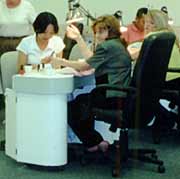 … and Kin
… and Kin
Kim’s Nails is the first of three Vietnamese-owned and -operated nail salons to open in Edgewater alone over the last five years. Of the more than 7,000 licensed manicurists in Maryland, over half are Vietnamese.
When Nguyen settled in Edgewater, his younger sister, Cindy Lam, who had been living in New Orleans with their father for almost 10 years, traveled north to join him. For many Vietnamese manicurists, language is a deciding factor in taking up the nail file. Gluing an acrylic tip on an index finger doesn’t require much understanding of English; a technician can get by on hello and thank you. Lam, 24, is an honor student fluent in English. She relinquished an academic scholarship at the University of New Orleans before taking a crash course in nails.
“You need to understand,” explains Lam. “My motivation to make money was very strong. I came to this country with nothing, and I knew that there was money available through the nail business. I was ready to start making money.”
A good manicurist makes $2,000 a month not including tips; owners make more. Recently, Lam bought a new home with her fiancé, Danny Nguyen (a ubiquitous Vietnamese surname), who is also a manicurist at Kim’s Nails.
The shop’s original owner, Kim (also Vietnamese), sold her business to Nguyen after only one year. The spacious storefront salon was mostly in place, but over the years Nguyen has labored to broaden an initially spindly clientele and to update the shop’s features and décor.
“We started with three manicurists, and now we have six, all Vietnamese. It’s easier to employ our own people. We understand each other,” says Nguyen.
The American Way
Hard work and volume trade has made his business thrive. “Some days we have one hundred customers,” says Nguyen. “We’re willing to stay open for long hours and take more customers and charge them less money than full service salons. A manicure is only $12, and a full set of acrylic nails is only $35. In the long run, we do better.”
He has also remodeled the shop, adding new sinks, counters, pedicure chairs and a waxing room. The shop’s ventilation system has recently been improved to reduce the fumes endemic to nail salons. Nguyen and his staff occasionally attend hair and nail shows to improve their technique and to stay abreast of the latest trends and developments in the field.
America’s new Vietnamese immigrants have democratized the manicure. In lowering the cost, Vietnamese manicurists have made their services accessible to women outside of the glamour girl and ladies-who-lunch circles. In being quick and convenient, they have made their services easily available to busy mothers and working women.
Kim Farrell is drying her freshly painted pink nails underneath a warm fan and ultra violet light encased within a long Formica counter, another of the shop’s new features. “The color is ‘Your Villa or Mine.’ I usually like red, but they’re pushing pink today,” says Farrell, referring to her biweekly manicure. “I work in downtown D.C. I don’t have a lot of time, so I stop by Kim’s Nails, and I’m in and out pretty quickly. It’s very convenient; otherwise I probably wouldn’t bother with my nails at all.”
When Nguyen and Lam left Vietnam, it was a very scary time: They were unsure what awaited them in the States, and they believed that they would never return to their country. Now, they visit frequently and are in a position to offer financial support to their family who remain behind. But there is no question of ever returning to live in Vietnam. “It’s understood that we are living in the U.S. for the rest of our lives,” says Lam quietly but firmly.
For Nguyen, his expensive car and the diamonds dangling from his sister’s ears are certainly carrots coaxing him along in his chase after the American dream. But the goodies and cash alone don’t finish spelling success for him.
“Becoming a U.S. citizen was a big moment for me,” smiles Nguyen as he greets his next client, a Navy man in need of a pedicure. “But I really felt that I had done something when I established a successful business out here in Edgewater, independent from the Vietnamese community. I always felt that if I could do that, then I would know that I was doing good.”
In that sense, he has made it.
Patrick Folliard, of Crofton, has written for New York magazine and The Washington Post before moving up to Bay Weekly.
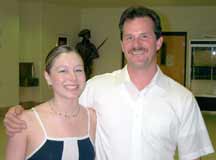 The
The
Twinkletoed: Why Are These People Dancing? From under two to over 80, Diane Herbert’s dancers are having fun.
story & photos by Amanda Lofton
A sea of reindeer antlers and elves surges in the Mary Harrison Cultural Arts Center. It’s sweltery summer outside, but inside, it’s Christmas. On stage, more of Santa’s helpers - princesses, little mouseketeers and winged creatures - wait their cue. Anticipation is nearly tangible in the mixture of excitement and stress that goes with all dance rehearsals and performances of the Diane Herbert All Star Revue.
It seems the cat has the tongue of the youngest performer, 22-month-old Torie Alexander. The miniature dancer hasn’t a word to share. All of this shyness must be an act, for as soon as her toes touch the stage, she explodes in exuberant expression. Mostly following her own choreography, Torie certainly feels the music as she skips, claps and dances to the irritatingly catchy Mickey Motion.
Torie’s great-great grandmother, 83-year-old Miriam Sellers, is the oldest dancer in this 43-number summer production. Sellers, Diane Herbert’s mother and a former Rockette in Radio City’s famous chorus line, has been dancing since, she says, “I started walking.” Perhaps that’s what keeps her looking so young.
For Sellers and her relatives, dance is in the blood. Taught by her parents, Sellers spent her teenage years traveling with her older brother as a dancing partner and performing in venues as notable as the nation’s Capitol. When she married, her husband built a studio in their home, where she taught her three daughters who, along with two of her granddaughters, became dance instructors themselves.
All for Fun
What is so appealing about dance that it joins a span of five generations together? Fun!
“It’s all a lot of hard work but when you enjoy it, it’s not unpleasant work. We like to perform,” says Sellers. The excitement of performing for an audience is echoed by Meghan Sullivan, 15, of Chesapeake Beach. “It’s thrilling and it’s really stressful. But it’s all worth it in the end.”
For the fathers present, their explanation of fun is sharing an experience with their daughters. It has taken Doug Hull 10 years of begging and pleading from step-daughter Ashleigh Bankus, a recent graduate of Southern High School, to agree to join in a father-daughter dance for the show. His reevaluation was pushed by the swift passing of time. “As they get older and older, you spend less and less time together and this is something she enjoys,” he says. Ashleigh proudly responds, “I’ve wanted him to dance with me forever, so I’m really glad!”
 For other dads, dance is not so unfamiliar. Glenn Martin, father of Sara, 12, explains, “I danced in high school plays so I had an interest in this sort of thing.”
For other dads, dance is not so unfamiliar. Glenn Martin, father of Sara, 12, explains, “I danced in high school plays so I had an interest in this sort of thing.”
Wayne Reed has been dancing with daughter Tiffany, 16, for 12 years. “When Tiffany was four, we did a father-daughter dance. It just went on and on from there … it’s neat. It’s a good time to be with the kids and see them all grow up.”
Sellers concurs that love of dance keeps members of her family close. “We stayed together. We do everything together. My three daughters and two granddaughters teach dance. We go to dance conventions all together, to New York mostly.”
Besides dancing for the sake of daughter Cara, 15, Dawn Mallonee admits to encouraging her daughter to begin dancing as a child because she was shy. Mallonee considers dance a confidence builder. Judging from Cara’s energetic and technically impressive style that earned her a place as one of ‘Diane’s Dynamites’ - the top team - mother may be right.
Ashleigh Bankus echoes this confidence in explaining how she came to solo at Southern High School’s spring dance show. “You have to get picked [by instructor Patty Jepson] to do it. It was my senior year and I was the only solo. It was really special.”
Sellers agrees on the merits of dance as a confidence builder, particularly for the young ones. “It helps them in school and being in front of people.” You can’t argue with a woman who has watched her three daughters learn to dance as they learned to walk.
For Meghan Sullivan, dancing is more fun because of the relationships she has formed throughout the past 12 years. “My instructors and fellow dancers are really nice. They are people you can talk to if you have problems. We’re all friends.”
Sellers found particular gratification when she instructed and performed for an audience of senior citizens. “I was an instructor for 60 years. After I retired, I didn’t really stop. I went to teaching senior citizens for about 12 years.” ‘Seller’s Golden Grannys’ traveled to nursing homes and “brought smiles to those who were so lonely and sick. They couldn’t come to dance shows, so we brought the show to them. There’s nothing like seeing some older ones smile and enjoy themselves,” she says.
Fun for All
Dance brings entertainment to more than just the performers, according to the leader of this motley yet adorable crew, Diane Herbert. With an obvious and deserved pride in the organization and continuity of her own production, she says she appeals to all tastes in music and dancing styles. “If you don’t like ballet, then the next dance is jazz and the next is a funny one.”
Sellers and the others have waited patiently for this three-hour rehearsal that doesn’t show signs of an imminent end. The faces of the tiny dancers, the teenage girls, their parents and especially Miriam Sellers reveal that indeed it is worth the sacrifices of time, stress and even a few embarrassments.
Whatever their motivations, these dancers thrived on the applause of the audience, the patience of director Herbert and the proud smiles of the dancing dads as they twirled their daughters to Little Bitty Pretty One.
Amanda Lofton, of Harwood, is a summer intern at Bay Weekly. In the fall, she returns to Western Maryland College for her senior year.